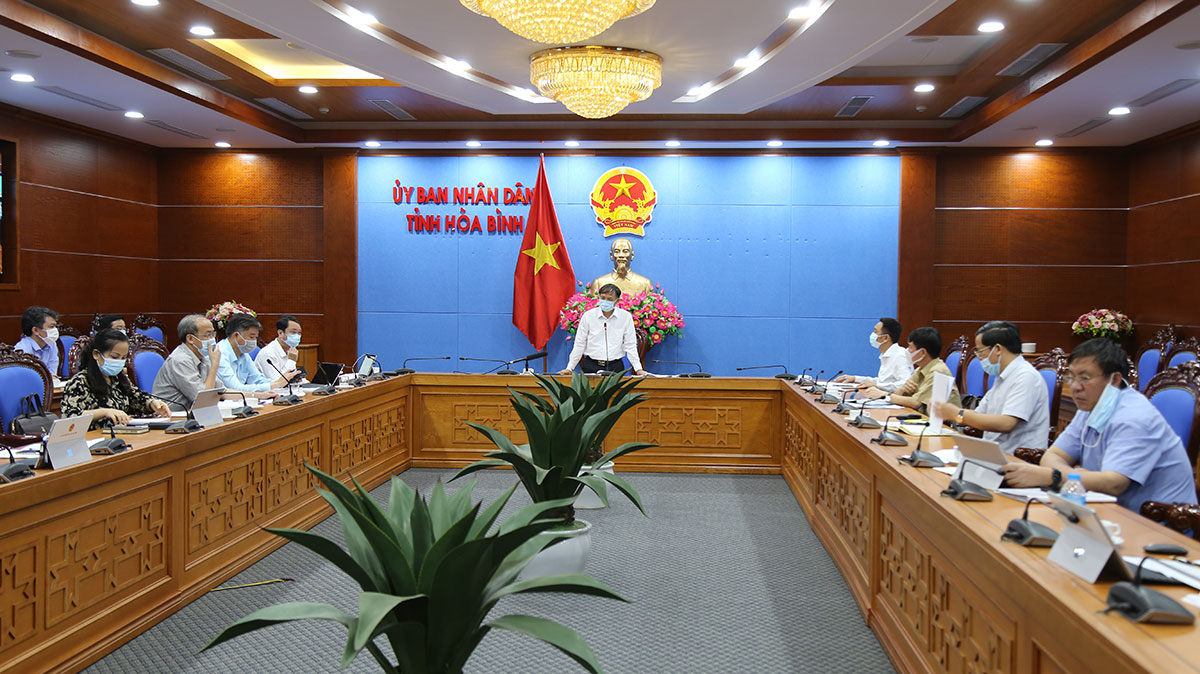
(HBO) – The Hoa Binh provincial People’s Committee on May 19 held a teleconference of the steering board for improving the local investment and business climate and the Provincial Competitiveness Index (PCI).
 Bui Van Khanh, Vice Secretary of the provincial Party
Committee and Chairman of the provincial People’s Committee, addresses the
meeting.
Bui Van Khanh, Vice Secretary of the provincial Party
Committee and Chairman of the provincial People’s Committee, addresses the
meeting.
In 2020, the provincial People’s Committee
issued Decision No 97/QD-UBND on a plan to continue carrying out the main tasks
and solutions to improve the business climate and the PCI of Hoa Binh. It also
issued Dispatch No 722/UBND-NC on May 6 last year on the implementation of
activities to raise the province’s ranking in terms of regulatory compliance
costs. A number of working sessions and dialogues were held to tackle
difficulties facing enterprises and investors. Authorities also did a good job
of assisting businesses affected by the COVID-19 pandemic.
Those efforts have helped improve Hoa Binh’s
position in the PCI rankings by four places, from the 48th in 2019 to the 44th
out of the 63 provincial-level localities, meeting the target set in the
resolution of the 17th provincial Party Congress for the 2020 - 2025 tenure.
To better the province’s score and position in
the PCI rankings as in line with the 17th provincial Party Congress’s
resolution, many officials held that departments, sectors, and localities need
to raise the sense of responsibility towards duties and the working capacity of
personnel in charge of investment attraction, increase vocational training for
labourers, and step up the reform of administrative procedures, especially
shortening the time needed to grant investment licences.
Addressing the event, Chairman of the provincial
People’s Committee Bui Van Khanh appreciated efforts by departments, sectors,
localities, and the local business association in 2020 in helping Hoa Binh go
up in the PCI rankings.
As it is not easy to further improve the
province’s score and ranking, it is necessary for the entire political system
to make stronger efforts, he noted, asking for administrative reforms to be
accelerated and online public services at Level 3 and 4 to be boosted./.
According to data from the Hoa Binh Provincial Party Committee, the industrial production index for the first six months of 2025 is estimated to have increased by 20% compared to the same period last year. This marks the highest year-on-year growth rate for this period since 2020.
In the first six months of 2025, Hoa Binh province’s export turnover was estimated at 1.145 billion USD, marking an 18.11% increase compared to the same period in 2024. Import turnover was estimated at $ 804 million, a 17.15% increase, which helped the province maintain a positive trade balance.
The lives of the ethnic minority farmers in Tan Lac district have gradually improved thanks to the new directions in agricultural production. This is a testament to the collective strength fostered through the professional associations and groups implemented by various levels of the district’s Farmers’ Union.
With the motto the "product quality comes first,” after nearly one year of establishment and operation, Muong village’s Clean Food Agricultural and Commercial Cooperative, located in Cau Hamlet, Hung Son Commune (Kim Boi district), has launched reputable, high-quality agricultural products to the market that are well-received by consumers. The products such as Muong village’s pork sausage, salt-cured chicken, and salt-cured pork hocks have gradually carved out a place in the market and they are on the path to obtaining the OCOP certification.
In the past, the phrase "bumper harvest, rock-bottom prices" was a familiar refrain for Vietnamese farmers engaged in fragmented, small-scale agriculture. But today, a new spirit is emerging across rural areas of Hoa Binh province - one of collaboration, organisation, and collective economic models that provide a stable foundation for production.
Maintaining growing area codes and packing facility codes in accordance with regulations is a mandatory requirement for agricultural products to be eligible for export. Recently, the Department of Agriculture and Environment of Hoa Binh province has intensified technical supervision of designated farming areas and packing facilities to safeguard the "green passport" that enables its products to access international markets.



 Bui Van Khanh, Vice Secretary of the provincial Party
Committee and Chairman of the provincial People’s Committee, addresses the
meeting.
Bui Van Khanh, Vice Secretary of the provincial Party
Committee and Chairman of the provincial People’s Committee, addresses the
meeting.